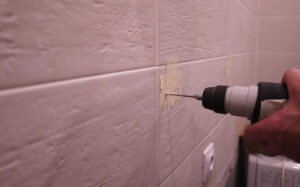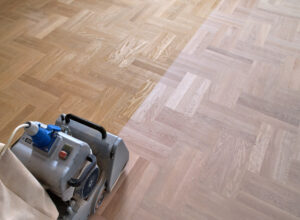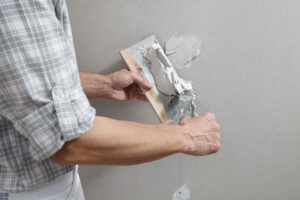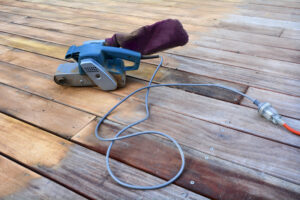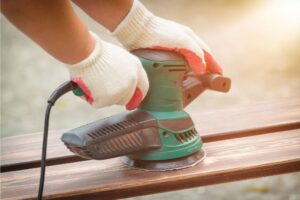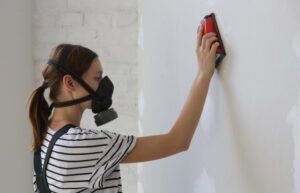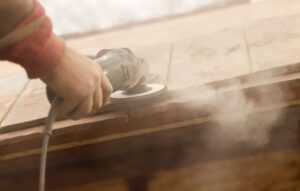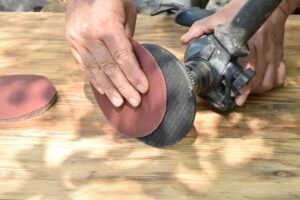The first thing you need to do if you’re considering sanding your floorboards by hand is to ask yourself why.
Hand sanding your floors takes an incredible amount of time and effort. If you are going to undertake this mammoth task, you need to make sure that it’s worth the blood, sweat, and tears you’re going to put in.
In this article, we’re going to look at the benefits and drawbacks of sanding your floorboards by hand compared with using a floor sander or hiring a professional.
Sanding by Hand
When we talk about sanding floorboards by hand, we mean using a hand power sander like an orbital sander or a detail sander.
Nobody is expecting you to use a sandpaper block on your living room floors. You would need to be seriously masochistic to undertake that task.
Let’s take a look at what’s good and bad about sanding by hand.
Advantages
The main advantage of hand sanding your floorboards is the lower cost. Most people tend to have or know someone who has a hand sander. Hand sanding can save you the cost of renting a floor sander or paying a professional.
Even if you need to rent a hand power sander, they tend to be cheaper than their massive floor sanding sibling. This is all down to the smaller size of hand sanders.
On a similar note, one of the advantages of hand sanders is the fact that they can be transported and used by one person. Large floor sanders often require two people to move them into place which can cause problems if you’re working alone.
Sanding the floors with a smaller hand sander also means that you can work to your own schedule, something you wouldn’t be able to do if you were hiring a pro or renting a machine.
If you fancy doing a bit of sanding at midnight when you can’t sleep, you absolutely can. Your neighbours might complain, but you can technically do it.
Another advantage to their small size is the fact that they can be used on difficult areas like the stairs and landing. You might not always be able to fit a floor sander in these areas.
Perhaps the only time when you should use a hand sander over a massive floor sander is if you are trying to protect the colour and shape of older floorboards.
Hand sanders are gentler and have less power which means that they remove less material than floor sanders. This makes them ideal for preservation work because they remove as little of the patination as possible.
Patination, or patina, is the various marks and signs of age, wear, and tear that accumulate over time. These marks add character and life to furniture and floorboards.
Disadvantages
The major disadvantage of hand sanding your floorboards is the fact that it is so dang time-consuming.
Handheld sanders are less powerful than floor sanders which means that it will take you longer to remove the same amount of material.
You could end up spending two weeks on your floorboards depending on how large the area is. Make sure you fully understand; hand sanding floorboards is not a quick job.
As well as being incredibly time-consuming, sanding by hand is also backbreaking work in a very literal sense.
You will be on your hands and knees for hours a day, over the course of several days. This can cause backaches and strains, bruising and pain in your knees as well as your wrists.
If you’re determined to sand by hand, make sure that you get something to kneel on whether it be knee pads or a cushion. Also, make sure you take the time to stretch and relax your back every half hour or so.
Hand sanders can also do more damage than good if used incorrectly. If the sander has a set pattern, like an orbital sander, it can leave gouge marks on your floorboards.
Another thing to consider is whether or not hand sanding actually is economical. Handheld sanders use smaller sanding paper than floor sanders, this means that you go through it quicker. You may find that you end up spending more on sandpaper than if you’d just rented a floor sander.
Floor Sander
Floor sanders are a type of drum sander. They have two drums and a loop of sandpaper that connects the drums. The front drum spins when the power is on which draws the sandpaper through in a continuous loop.
In a sense, they are similar to belt sanders, but they are much larger and more powerful.
Advantages
Probably the best thing about floor sanders is the fact that they are quicker than other methods. The drums spin very quickly which gives these sanders cutting power rather than grinding power.
The force of floor sanders can be used to remove built-up layers of varnish and paint as well as wood. They are awesome at removing tough, caked-on finishes and stains which can be a godsend for old floorboards or heavy-traffic areas.
Floor sanders can also be used to level floorboards. This is because they have so much cutting power. In effect, they act like planers.
Despite the fact that these machines are incredibly powerful, they often create far less dust than hand sanders. Usually, floor sanders have a built-in vacuum that collects the dust as it’s created.
They’re not dust-free, but they can significantly reduce the dust created by sanding. In some cases, dust can be reduced by up to 98%.
Finally, floor sanders tend to operate in an upright fashion. This means that you won’t spend hours bending and straining your back.
Disadvantages
The biggest issues with floor sanders are the cost and the size of the machines.
In terms of cost, most people tend to rent floor sanders because they are massively expensive to buy. An upright floor sander can easily cost you over a thousand dollars to buy new.
When you realize that you’re only going to use the machine once every few years, the cost seems even worse.
Renting a floor sander typically costs between $50 and $100 a day. You can rent them from your local hardware store or tool hire place.
In terms of size, floor sanders can be hefty machines. They often require two people to safely lift and carry them into place.
They’re also not suitable for narrow or small areas. This means that they are usually not suitable for staircases or landings. Especially if the boards run horizontally across the landing because you can’t sand at a 90-degree angle to the board.
The other thing to remember about floor sanders is that they can cause irreparable damage if used incorrectly. These machines work fast, and they work hard. If you leave them in one place for too long, they will gouge at the floorboards. It’s always good to remember that once material has been removed, it can’t be replaced.
Hiring a Professional
If you’re unsure how to sand your floors or just don’t fancy it, you can always call in a pro. Check with your local flooring store to see if they offer a sanding service.
You can also check online for hundreds of floorers available to work in your area.
Advantages
The major advantage of hiring a professional is the fact that you don’t have to lift a finger. They will take care of the preparation, the sanding, and the cleanup for you.
The most you’ll have to do is give them a call and offer refreshments while they work.
Hiring a professional also gives you peace of mind. They are trained and skilled which means they’ll likely do a better job than your average DIYer.
You’ll also probably get a warranty with the service. This means that if you notice any mistakes or have any issues, the company will take care of them at no extra cost.
Professionals also bring all the tools with them, so you don’t have to worry about sourcing a floor sander or vacuum.
Disadvantages
Professionals cost money and for some people, they simply cost too much.
The average cost for floor sanding is between £1 and £5 per square foot, but this can run as high as £8 per square foot for more complex jobs.
The average living area is about 330 square feet which means that you can expect to pay between £300 – £1650. The price can increase if your floor requires more than one pass with the sander.
Final Thoughts
Sanding your floors by hand is an arduous task that requires a lot of patience and a fair amount of skill. It can be done, but often it’s easier to rent a floor sander. These machines are specifically designed for sanding floorboards and making short work of the job.
- Drill Battery Maintenance: Essential Tips for Cordless Drill Battery Care - February 5, 2024
- Troubleshooting Drill Issues - February 5, 2024
- Quick Drilling Techniques - February 2, 2024

